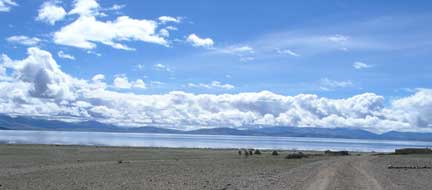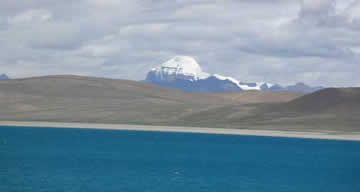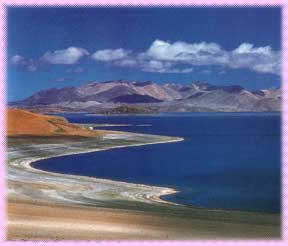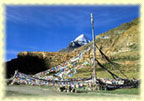|
The Holy Manasarovar Lake Manasarovar is the holy lake for Hindus, Bons, Buddhists, and Jains. Hindu claim the holy lake is a creation of Brahman: the creator of perfection. Buddhists believe the holy lake is dwelling of Je Tsun Dorjee Dorjee Naljor Ma: the mother of tantric teachings of Buddhism. Bon religion believe that Kailash and Manasarovar are two sides of a coin: the crystal stupa, Kailash, attracts devotees and the turquoise morrow, Manasarovar, fulfils their wishes. It is a common belief that the water of Manasarovar has the power to cleanse negativities deeds and enrich virtue and happiness on the continuous journey of life. The lake is called the merrow because it crystal clear water reflects the beautiful surrounding environment and the snow-capped sacred Mount Kailash. The lake covers 412 square kilometers at an altitude of 4588 meters. Tibetan Belief of Holy Manasarovar Lake  Tibetan believe that Je Tsun Dorjee Dorjee Naljor Ma has established Manasarovar lake as the palace of the four tantra sections. These are Je Grud (action tantra), Chod Grud (performance tantra), Naljor Grud (yoga tantra) and Naljor La Na Med Pe Grud (unsurpassed yoga tantra). Tantra and Sutra are the two paths, which are practiced by Buddhists to seek for liberation from the circle of birth and death. Manasarovar is called Tso Rinpoche, which means "the holy lake" in Tibetan. There are a number of books about the preciousness of the lake. In the 5th century, according to the Kagyu Pa Order, the historical Buddha Shakyamuni appeared miraculously at Manasarovar and Mount Kailash with five hundred warriors against evil (Gra-chom pa or Arhat). The buddha consecrated Manasarovar and gave teachings to the King of Naga, known as Ga-O, and the living beings in the lake. The collection, Book of Superiors' Speeches, also asks, "if the King of Naga is not in Manasarovar, how do rivers flow in this world? If there are no rivers, there would be no vegetation". Manasarovar River is regarded as the source of the four great rivers - Senge Khabab (Indus), Tachog Khabab (Brahmaputra), Langchen Khabab (Sutlej) and Maja Khabab (Karnali) - which cover half of the world. It is believed that, before the continents separated, these rivers flowed over all the world. The World of Nagas Nagas are a type of living being who occupy one of the three worlds: Me Yul, "the human world", is situated in the middle; Lha Yul, "the god or celestial world", is above; whereas Klu Yul, "the Nagas world", is below. In the biography of the legendary King Norsang, Manasarovar Lake is called the Lotus Lake of Naga, so-called because its shape is similar to a lotus flower which has a hundred petals. From each petal flows a river and at the source of each river is a Naga residence. The King of Naga is known as Kyi Wa Natsog and rules over several states of Naga. Every month his subjects burn incense and make Torma offerings at the river sources, burying a vase of Torma offering every year. The prosperity and happiness of the northern King, Norsang, and his subjects depends on the lake and the King of Naga. Zambu Krita Tree Zambu Krita is a species of tree which is believed to grow in the lake. The great Buddhist masters, including Guru Rinpoche, said they could see a live tree in the perception of those who have gained higher stages of spiritual realization. Its root is in the world of Naga, the branches are in the human world and the top of the tree appears in the world of gods or celestial beings. The branches are occupied by the lineage masters of the Kagyu Pa Order: in the centre is the Dharma protector, Dorjee Pegmo and her attendants; at the root is the compassionate King of the Nagas, who gives teachings to the Naga beings. Once upon a time, a seed of Zambu Krita fell in the lake where it created a sound, "Zam". This world is therefore called Zam Bu Ling. In the 12th century, a Buddhist practitioner, Drikung Cha Nga Ling pa, went to wash himself in Manasarover and he hung his robe up on the tree. Since his followers were unable to see the tree, it appeared as if his robe was hanging in the air. On another occasion, Cha Nga Ling Pa received an invitation from the king of Naga who asked for his teachings. He sat in the lotus position on the water at the lake's shore and was taken to the centre of the lake as if he was still on the same spot. Then he was offered an image of Buddha Shakyamuni, known as Thupa Chu Nyir Ma. The size of the image is twelve-fingers broad and it is believed to have been blessed by Buddha Shakyamuni himself. Currently, the image is kept in Ayang monastery in Southern India. Finally, the fourth Panchen Lama, Losang Choekyi Gyal Tsen, offered a Kateg (a white scarf) to Manasarovar with his prayers and admiration. The Kateg hung on the Zambu Krita tree for a week but, since no ordinary person can see the tree, everyone thought the Kateg was hanging in the air. The Undefeated Turquoise Lake
Ma Pem Yu Tso is another name for Manasarovar. It means "the undefeated turquoise lake". It is called undefeated because the water possesses eight qualities that no other water can compete with. These qualities are: it is clean (it does not smell or contain any toxic substances); it is clear (with no mud or dirt); it is cool (free from heat); smooth (has no flavour of aching and uneasiness); secure (has protective powers to secure health); delicious (not salty or bitter), quenching (fully satisfies thirst) and good (causes no sickness or unhealthiness). Manasarovar is also called Ma Droe Tso, which means "the unwarmed lake". Originally, there was no lake there. The land was ruled by King Nyugbam, a Bodhisattva. One day, as he walked in his garden, he saw an elderly man who was suffering grievously from a disease. The king summoned all the spiritual teachers, practitioners and Brahmans and asked for their answer as to whether birth, old age, sickness and death would only befall the old man or would they affect all living beings? They answered that all sentient beings would be affected. After careful consideration, the king posed a second question, what can be done to help? The members of the gathering suggested practising generosity. For the following twelve years, the king gave food, clothing and other riches to all beings. Manasarovar is believed to have been created from all the water which was emptied out after rice had been cooked. The lake became bigger everyday but, because of the cool climate, it never became warm. Where the lake overflowed, the river was called Das Khu in Tibetan (which means "the light of rice") and River Ganges in Sanskrit. |
|
||||||||||||||||||||||||||||||||||||||||||||||||||||||||








